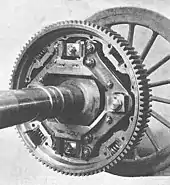

The Winterthur universal drive or SLM universal drive (German: Universal-Antrieb Winterthur) was a drive for electric locomotives invented by Swiss engineer Jakob Buchli at Swiss Locomotive and Machine Works (SLM) in the 1920s.
Design
After developing the successful Buchli drive at Brown, Boveri & Cie (BBC), Buchli moved to SLM at Winterthur in 1924, where he designed the universal drive. It was characterised by double gearbox, which enabled the transmission ratio to be selected freely within a wide range.[1] Two coaxially opposed motors were arranged in the frame above each drive axle. The driving wheels were driven by a double gearbox, the second being connected centrally to the driving wheels by means of a universal joint.[2]
Service
The Winterthur universal drive was extensively used by SLM in locomotive designs from 1928 to 1948.[3] It was compact and had a relatively light unsprung weight. However, it was difficult to access for maintenance and repair work, a particular problem as the gears were prone to wear. The drive was unpopular amongst drivers due to loud noise that it made, and production was discontinued when the design was rendered obsolete with the advent of lighter motors which enabled the modern axle-hung (also known as nose-suspended due to the "nose" that transfers weight and torque to the frame), direct-drive designs.[4]
Locomotives
| Nationality | Operator | Class | Quantity produced | Years constructed | Manufacturer | Wheel arrangement | |
|---|---|---|---|---|---|---|---|
| GIPR | EA/1 | 22 | 1928–1930 | SLM, Metrovick | 2′Bo(A1) |  | |
| GIPR | EA/2 | 1 | 1938 | SLM, Metrovick | 2’Bo(A1) |  | |
| SBB-CFF-FFS | Ae 8/14 11851 | 1 | 1932 | SLM, MFO | (1A)A1A(A1)+(1A)A1A(A1) |  | |
| SBB-CFF-FFS | Ae 8/14 11852 | 1 | 1938 | SLM, BBC | (1A)A1A(A1)+(1A)A1A(A1) |  | |
| SBB-CFF-FFS | Ae 4/6 | 12 | 1941–1944 | SLM, BBC, MFO, SAAS | (1A)Bo(A1) |  | |
| NS | 1000 | 10 | 1948 | SLM, Werkspoor | (1A)Bo(A1) |  |
See also
References
- ↑ Buchli, Jakob (1927). "Universal-Antrieb "Winterthur" für elektrische Lokomotiven". Schweizerische Bauzeitung (in German). 90: 194–196.
- ↑ Sachs, Karl (1955), "Die schweizerische Entwicklung im Bau elektrischer Lokomotiven für Adhäsionsbetrieb", Schweizerische Bauzeitung (in German), 73 (42): 639–643, doi:10.5169/seals-62004
- ↑ Bärtschi, Hans-Peter (1998). "Elektrolokomotiven aus Schweizer Fabriken". In Verkehrshaus der Schweiz (ed.). Kohle, Strom und Schienen: Die Eisenbahn erobert die Schweiz (in German). Zürich: Verlag NZZ. ISBN 3-85823-715-9.
- ↑ designhttps://rdso.indianrailways.gov.in/works/uploads/File/Selection%20of%20Suspension%20Arrangement%20of%20Traction%20Motors%20%20A%20Right%20Approach.pdf